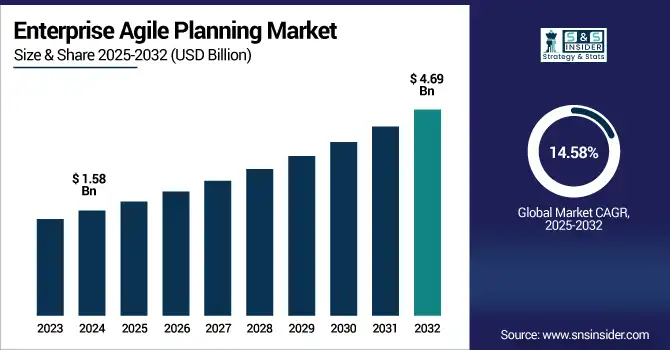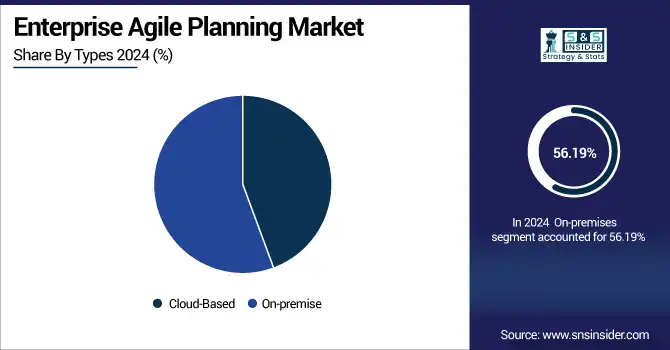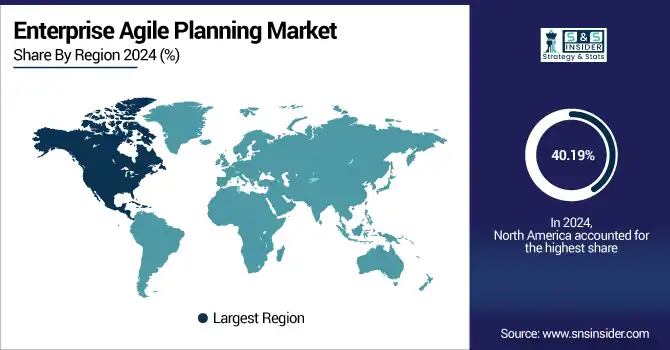Enterprise Agile Planning Market Report Scope & Overview:
The Enterprise Agile Planning Market size was valued at USD 1.58 billion in 2024 and is expected to reach USD 4.69 billion by 2032, expanding at a CAGR of 14.58% over the forecast period of 2025-2032.

To Get more information on Enterprise Agile Planning Market - Request Free Sample Report
The demand for the Enterprise Agile Planning (EAP) market is rapidly growing as enterprises demand productivity and competence tools to obtain greater flexibility, faster delivery, and enhanced collaboration. Agile planning tools facilitate the management of projects, resource optimization, and adaptation to changing demands using methodologies such as Scrum and Kanban. The trend towards remote work and the need for scalability is making cloud-based solutions more popular. AI-enhanced tools like predictive analytics can give project outcomes a boost. These tools are being embraced by critical sectors such as IT, healthcare, and manufacturing to enhance productivity and drive innovation. While there are challenges due to integration issues and poor acceptance of Agile itself, the market is large for vendors with sophisticated and easy-to-use Agile planning solutions.
According to research, over 45% of enterprises using Agile planning tools have reduced product delivery cycles by over 30%, while nearly 70% integrate these tools in remote work strategies, boosting resource utilization efficiency by 35% across IT and manufacturing sectors.
The U.S Enterprise Agile Planning Market size reached USD 0.51 billion in 2024 and is expected to reach USD 1.40 billion in 2032 at a CAGR of 13.63% from 2025 to 2032.
The U.S is a major contributor to creating the demand for Agile and DevOps software in the market, due to its stable development of IT infrastructure, early adoption of Agile methodologies, and solid presence of technology-driven enterprises. The increased focus on digital transformation initiatives and the need to accelerate product development cycles only adds to the demand. The acceleration of remote and hybrid work models has also fueled the acceptance of Cloud-based Agile planning solutions. Top movers for improvement are collaboration, real-time project tracking, and the integration of DevOps and other enterprise systems.
Market Dynamics
Drivers:
-
Growing Demand for Enhanced Collaboration and Real-Time Project Visibility Drives Agile Planning Adoption Across Enterprises.
The need for better collaboration and real-time visibility of projects is a major trend that is driving enterprises to adopt Agile planning solutions. Organizations are trying to achieve effective communication across cross-functional teams, breaking down departmental silos, and increased transparency of project progress. This allows for faster decision-making and greater responsiveness to changing business needs. Moreover, as remote and hybrid work models have become prevalent, so too has the demand for centralized, real-time insights available wherever your data lives. However, recent trends suggest growing integration of AI and machine learning into the Agile planning platform to offer solutions to predictive analysis, automated reporting, and resource allocation, which injects power into collaboration and operations.
Restraints:
-
Organizational Resistance to Change and Traditional Mindsets Hinder Agile Planning Implementation in Enterprises.
Organizational change resistance is the first restraint to the wide adoption of Agile planning methodologies. For many enterprises, this shift is made difficult by deeply entrenched cultural mindsets, hierarchical structures, and the mobile nature of the core projects of these global behemoths, all of which combine to create an unwillingness to alter legacy project management processes. This resistance typically leads to extended adoption cycles and misuse of Agile tools. Likewise, poor training and change management make matters worse, preventing Agile from reaching its full potential. Existing literature shows that to overcome these cultural challenges, visible leadership commitment, organization-wide training, and stepwise change management strategies are needed to implement Agile practices successfully at scale in an enterprise.
Opportunities:
-
Increasing Integration of Artificial Intelligence and Machine Learning Technologies Offers Significant Growth Opportunities.
Integration of AI & ML with Agile planning solution is a significant opportunity for the overall market. With these technologies, the organizations are capable of using predictive analytics for sprint predictions, sprint risk, and resource prediction, thus resulting in enhanced project quality. Powerful automated task prioritization and intelligent reporting features minimize the manual effort required and increase productivity. To align with this trend, vendors are innovating to integrate AI/ML capabilities, setting themselves up with differentiated solutions for complex project management requirements and establishing their unique positioning in this changing market landscape.
Challenges:
-
Complexities in Scaling Agile Practices Across Large Enterprises Pose Significant Challenges.
Scaling Agile practices across large, complex enterprise environments continues to be a key challenge. In contrast to small teams, where the decision-making is limited to the context of the team, the structures, business units, and outcomes are complex for larger organizations, making it difficult to adopt Agile uniformly with the needs of multiple stakeholders. The key hurdles lie in bringing alignment among different departments, integrating Agile with existing legacy systems, and maintaining consistency of practices. Current research claims that without an articulated scaling strategy paired with genuine executive sponsorship, organizations run a high risk of siloed Agile implementations that do not confer the desired organization-wide benefits.
Segment Analysis
By Application
The Large Enterprises segment holds the largest revenue share of 22.40% in 2024, supported on the basis of the high requirements for comprehensive, scalable Agile planning solutions for complex end-to-end project portfolios. Enterprise-ready Agile planning tools have been recently introduced by major companies, including Atlassian and IBM, which include capabilities like advanced analytics and coordination across multiple teams. These initiatives are in line with demand from large enterprises for single platforms that can integrate writing workflow and compliance. Its steady growth highlights enterprises' focus on accelerating digital transformation and operational efficiency, driving the Enterprise Agile Planning Market forward.
The Small and Medium Enterprises (SMEs) are expected to grow at a CAGR of 41.83% as a result of the growing penetration of low-cost and easily deployable Agile planning solutions. Startups like Monday. Light, elastic on on-demand products aimed towards startups were launched by competitors like Command and JIRA. These offerings allow SMEs to boost collaboration, improve the speed of delivery cycles, and increase competitiveness. This surge in adoption also highlights the increasing recognition of Agile advantages amongst the SMEs and makes this segment a key growth contributor to the Agile Planning Market throughout the forecast period.
By Types
In 2024, the On-premise segment held the largest revenue share at 56.19% and is expected to show a similar trend in the future, owing to enterprises emphasizing data security, control, and compliance. Mature vendors such as CA Technologies and Microsoft have launched enhanced on-premise Agile planning suites with new security measures and better integration. The industries with strict regulations, namely finance and healthcare, are driving the segment because they tend to opt for on-premise deployments to protect sensitive data.
The Cloud-based segment is anticipated to be the fastest growing at a healthy CAGR of 41.73%, owing to the increasing requirement for scalable, flexible, and accessible Agile planning solutions, positively affecting the segment growth. enterprise agile planning market companies, such as Smartsheet and Asana, have introduced cloud-native Agile planning platforms that focus on enabling seamless collaboration, automation, and real-time updates with built-in AI. Few enterprises struggle to find a reason to adopt the cloud since the cloud is easy to deploy and comes with a lower upfront cost, which appeals to all forms of enterprises that desire the benefits of agility, but are not willing to incur extensive IT overhead.

Regional Analysis
North America held the market share of 40.19%, which can be attributed to advanced IT infrastructure, higher adoption of Agile methodologies, and the presence of many major technology companies in the region. Major investments in digital transformation and innovation are creating demand for scalable enterprise Agile planning tools across various industries in the region.
The United States dominates North America due to its large technology sector, early Agile adoption, and significant investments in cloud-based and AI-powered Agile planning solutions.
Germany, with its large industrial base and the early adoption of agility thinking and frameworks, has been able to deliver high efficiency and restore innovation capability at the project level.
The growth of Europe’s EAP Market is expected to be fueled by the rise in digitalization and regulatory compliance requirements, along with a great focus on agile project management processes in automotive, finance, manufacturing, and other key industries.
Asia Pacific is the fastest-growing region with a CAGR of 15.97% due to the digitisation initiatives, broadening of IT offerings, and an increase in SME Growth. The region benefits from government support for the modernization of technology and a growing cloud adoption across the sectors.
China tops the Asia Pacific region, supported by a large and enterprise base, rapid enterprise agile planning market growth of tech startups, and active investments in digital and Agile.
The Middle East & Africa and Latin America markets are rapidly thriving due to the rising Agile adoption across numerous sectors such as finance, telecommunications, and the retail sector, along with IT infrastructure investment, cloud service deployment, and vigorous government initiatives in the UAE and Brazil.

Get Customized Report as per Your Business Requirement - Enquiry Now
Key Players
The major key players of the Enterprise Agile Planning Market are Atlassian, Digital.ai, Planview (LeanKit), IBM, Microsoft, Broadcom, GitLab, Targetprocess, Micro Focus, Planisware, and others.
Key Developments
-
In May 2025, Planview purchased Plutora to strengthen its Value Stream Management capabilities, such as release management, test environment management, and deployment planning, to further enhance its enterprise agile planning capabilities.
-
In April 2024, Microsoft was named a Leader in the Gartner Magic Quadrant for Cloud ERP, which showcased Dynamics 365's adaptable, composable solutions for service- and product-centric businesses.
| Report Attributes | Details |
|---|---|
| Market Size in 2024 | USD 1.58 Billion |
| Market Size by 2032 | USD 4.69 Billion |
| CAGR | CAGR of 14.58% From 2025 to 2032 |
| Base Year | 2024 |
| Forecast Period | 2025-2032 |
| Historical Data | 2021-2023 |
| Report Scope & Coverage | Market Size, Segments Analysis, Competitive Landscape, Regional Analysis, DROC & SWOT Analysis, Forecast Outlook |
| Key Segments | By Application (Large Enterprises, SMEs) By Types (On-premise, Cloud-Based) |
| Regional Analysis/Coverage | North America (US, Canada, Mexico), Europe (Germany, France, UK, Italy, Spain, Poland, Turkey, Rest of Europe), Asia Pacific (China, India, Japan, South Korea, Singapore, Australia, Rest of Asia Pacific), Middle East & Africa (UAE, Saudi Arabia, Qatar, South Africa, Rest of Middle East & Africa), Latin America (Brazil, Argentina, Rest of Latin America) |
| Company Profiles | Atlassian, Digital.ai, Planview (LeanKit), IBM, Microsoft, Broadcom, GitLab, Targetprocess, Micro Focus, Planisware |

